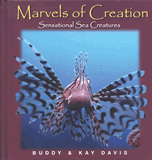
Grunting Fish a Tie to Evolutionary Vocal Cues
The latest entities speaking in favor of evolution may be 400-million-year-old fish, according to researchers reporting in the journal Science.
News Source
- BBC News: “Grunting Fish Yield Vocal Clues”
The researchers studied toadfish and their kin, midshipman fish, which use a variety of “grunts” to attract mates while intimidating the competition. Cornell University’s Andrew Bass, the aptly named lead author of the research, commented on fish communication habits:
“You’ll hear frogs calling, birds singing and we hear this all the time—we are familiar with this. But I think it’s fair to say that most people are unaware of the fact that many fish use sound for social communication. . . . They make different kinds of sounds in different social contexts. Just as birds will use one call to attract a mate and another call to scare a rival off, the fish do exactly the same thing.”
For example, the researchers discovered the fish use a “deep hum” to lure in females, while using a “sharp grunt” to defend their territory.
The team then analyzed the fish brains to determine what part is responsible for the vocal patterning. The “astonishing” surprise? The neural networks for vocalization in the fish brains are in the same region as in frog, bird, and primate brains. This spurred Bass to exclaim in astonishment, “Oh my god, this is all in the same place.”
Then, perhaps ironically despite the flippant divine reference, comes the evolutionary interpretation. For evolutionists, if a supposed lineage of creatures exhibits a similar anatomical feature, biological ability, or gene, the assumption is that it must have evolved once and then descended through the following generations. This is regardless of any differences between the feature/ability/gene in the organisms, since the differences are chalked up to mutations over the years. Thus, Bass’s team assumes the ability of vertebrates to vocalize comes from fish; since bony fishes date back to 400 million years ago (in the evolutionary interpretation of the fossil record), the team slapped the date of 400 million years on their fishy find.
In fact, when one presupposes the family tree of evolution, both similarities and differences become “evidence” to reinforce the evolutionary worldview. Morphological similarities? They’re considered signs of common descent or “convergent evolution.” Morphological differences? They’re used as signposts for when lineages diverged.
From the creation perspective, it makes complete sense that God, when fashioning numerous vocalizing creatures during Creation Week, would arrange their brains with some similarities—even though there are obviously many differences between fish, frogs, birds, and primates (to say the least)!
Further Reading
- The Origin of Vertebrates
- Why Shouldn’t Christians Accept Millions of Years?
- Information Theory
- Mutations
For More Information: Get Answers
Remember, if you see a news story that might merit some attention, let us know about it! (Note: if the story originates from the Associated Press, FOX News, MSNBC, the New York Times, or another major national media outlet, we will most likely have already heard about it.) And thanks to all of our readers who have submitted great news tips to us. If you didn’t catch all the latest News to Know, why not take a look to see what you’ve missed?
(Please note that links will take you directly to the source. Answers in Genesis is not responsible for content on the websites to which we refer. For more information, please see our Privacy Policy.)
Recommended Resources

Answers in Genesis is an apologetics ministry, dedicated to helping Christians defend their faith and proclaim the good news of Jesus Christ.
- Customer Service 800.778.3390
- Available Monday–Friday | 9 AM–5 PM ET
- © 2025 Answers in Genesis





